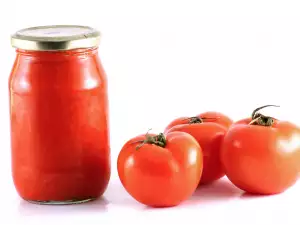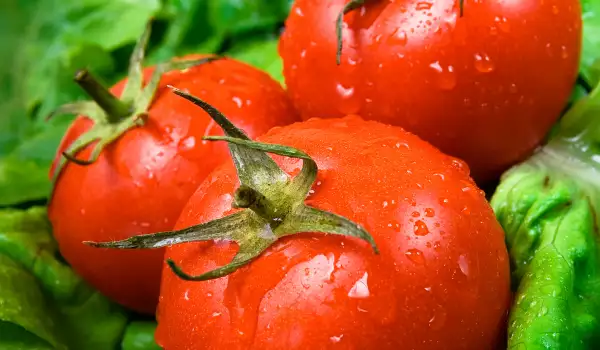Tomatoes are probably the most widely loved and popular vegetables in the world. Many believe that tomatoes are actually a fruit, but in view of their great taste and their widespread use, the battle of "fruit or vegetable" is forgotten behind. Tomatoes (Solanum lycopersicum) are vegetable species belonging to the Solanaceae family. They are grown for their delicious fleshy fruits, as annual crops. In some areas where air and soil temperatures do not fall below 0° C, they can be grown perennially.
Upon ripening, tomatoes become red, pink, yellow or orange in color, with different intensity. The bulk of the fruit varies widely - from 10 to over 200 types of fruits that may come with seeds or without seeds. The origin of tomatoes involves the equatorial rainforests of South America and they have specific requirements for the factors of their growth and development. Tomatoes are particularly demanding from irrigation, sunlight should be in abundance, but not overly strong and long.
In the eternal home of tomatoes, today we can meet their ancestors in a wild state. They are small as a walnut and are far away from the familiar taste of our tomatoes. Millennia ago, the inhabitants of Peru, Chile and Ecuador began to cultivate tomatoes. After the discovery of America, tomatoes began to enter the Old Continent. The name "tomato" comes from the word "tomalt" with which the Aztecs called the red vegetable when offering them to the Spanish merchants. Initially, however, they were grown as potted plants for decoration. Decades passed before they start to be used as food, and the first in this endeavor were the Spaniards.
Over the centuries, the varieties of tomatoes have widened considerably. Today, genetic engineering allows a wide variety of species (purple, blue, yellow, orange, etc.), with up to 500 representatives, this is a moisture-loving plant and is best grown at 25-30 degrees.

The Food and Agriculture Organization of the United Nations adopted an international standard for commercial tomatoes. According to the standard. a real tomato should be one of four shapes - round, ribbed, oblong and cherry (cocktail). The tomatoes must be undamaged, clean, fresh and not infected with pests. If tomatoes are for sale on the stem, there should be fresh, healthy and clean leaves on the stems.
Today, mass production of the tomato market is the cause of the influx of "artificial" vegetables that are far from the true taste and nutritional potential of ones grown outdoors in the warmer months. In plastic greenhouses are kept only hybrids with a high growth rate.
Scientists have even managed to identify a negative mutation gene, which leads to very high yields of tomatoes. It's about the so-called heterosis effect - when hybrids resulting from the crossing of two plant species or two breeds are more viable than their ancestors, give more fruit (wool, meat, etc.).
Composition of tomatoes
Tomatoes are an excellent source of antioxidants, lycopene and beta carotene. They are low in calories and high in vitamin C and A, which strengthen the immune system and break down fat. Their natural color has a powerful lycopene antioxidant. Tomatoes have a huge wealth of vitamins, minerals and other nutrients. Daily, we need a large tomato, in order to obtain almost all need as far as vitamin C and vitamin A go. Tomatoes contain 17 times more iron than milk, twice as much as eggs and three times more than fish. Ripe fresh tomatoes contain 2-3 times more vitamin C than green ones.

There is a variety in the chemical composition of tomatoes and they vary depending on soil and climatic conditions. Tomatoes are 94.5% water, 0.9% protein, 3, 5% carbohydrates, insignificant percent starch, 0, 7% cellulose, organic acids (citric, malic, oxalic). They contain minerals such as potassium, phosphorus, calcium, magnesium, sodium, iron, etc.. They have 30 mg vitamin C, 0.60 provitamin A, 0.85mg vitamin E, 0.50 mg vitamin C, 0.50 mg vitamin PP. Vitamins B1 and B2 are found in smaller quantities.
Selecting and storing tomatoes
Most taste and health benefits of the tomato come from ripe ones, not those that have been picked green and ripened in a crate. This is an important rule that must be observed when selecting tomatoes, though today it is confined almost exclusively to the "artificial" ones. When buying tomatoes, try to find balanced and deep red, fleshy and juicy ones. When it is chewed, it should not crunch. Because of the deterioration of the taste of tomatoes in recent years, consumers buy more pink tomatoes that are more expensive, but taste relike real traditional tomatoes.
If you choose a real tomato, it can be stored in a cool place for a few days. After this period, their sugars start to rapidly break down, resulting in increased acidity and then, the tomatoes are inedible. The pectin in them breaks down in parallel and, they begin to rot and decay. Uncolored tomato is to be kept at about 10 degrees.
Tomatoes should be cut immediately before use with a stainless steel knife, because they are perishable. This is due to vitamin C, which is highly unstable and quickly ruins in the presence of light and air, and from contact with metal. Proper pasteurization and proper storage of tomato juice and canned tomatoes may retain their nutritional values for approximately two years. Associates in New Delhi (India) created a new variety of genetically modified tomatoes that are stored for much longer than conventional tomatoes. Ordinary tomatoes begin to wilt and spoil after 15 days storage, the fruit of the new variety resistant GM tomato remains fresh for 45 days.

Culinary use of tomatoes
Perhaps the first associations that come to mind with tomatoes are salads, canned stew or savory tomato sauce that can actually be consumed with everything - vegetables, meats, pasta, etc. In the summer season, tomatoes tend to have free reign and in the fall, they are turned into tomato juice, casseroles or simply peeled tomato preserves. Tomatoes are the foundation of many of your favorite ketchups. Bolognese sauce for pasta and noodles would be unthinkable without fresh and ripe tomatoes.
Certain salads have long been respected because of the presence of tomato in them that gives them a unique flavor. Tomatoes are widely used in cooking, they are the ideal gadget for almost all dishes, stews, casseroles, pasta or macaroni, baked goods such as moussaca, etc. Traditional chutney has for centuries been a favorite of youngsters and adults because of the tomato magic it represents.
Benefits of tomatoes
Tomatoes are a faithful helper in dieting. They have diuretic properties and are excellent for diets for kidney disease, hypertension in diabetes (more acid varieties) in cardiovascular diseases. Tomatoes are an important food for men to prevent prostate disease.

Vast are the advantages of tomato juice, which melts fat and works well in diseases with impaired metabolism, such as arthritis, obesity, diabetes. In gastritis with low acidity, ulcers of the stomach or duodenum and for extreme exhaustion of the body, you need to drink 200 ml freshly squeezed tomato juice 30 minutes before meals.
A glass of tomato juice, procure half the necessary for humans daily dosage of vitamin A and vitamin C. Tomato juice stimulates the activity of the gastrointestinal tract and reduces the risk of cancer. It is very useful for pregnant and nursing mothers. It can dissolve animal fats and protect arteries from hardening.
The antioxidant lycopene in tomatoes helps to keep your skin radiant and toned. On top of that, lycopene acts even more powerfully with properly canned tomatoes. Tomatoes increase the level of procollagen in the skin, suggesting protection against sunburn. Sufficient intake of lycopene and beta-carotene in the summer naturally protects skin from harmful UV rays. There is even a tomato diet that melts fat successfully.
Researchers from Canada found that two glasses of tomato juice a day strengthens bones and prevents osteoporosis. Tomato juice is also a rich source of fructose. Like honey, it accelerates the combustion of alcohol in the body and is an assistant for hangovers. It is advisable to drink alcohol with a cocktail of honey, lemon juice and tomato, to prevent headaches in the morning.
Some studies even say that tomatoes increase libido and improve your sexual life. The reason lies again in the magical lycopene and total body toning. According to other studies, it is better to eat tomatoes with a little fat, which will help the body to absorb the maximum nutrients in them. High intake of fruits and vegetables with carotenoids such as tomatoes, reduces the risk of cancer.
Dangers of tomatoes
Tomatoes may be contraindicated in people with active chronic allergies. They may experience allergic symptoms.



















Comments